Efficacy Testing Market Size
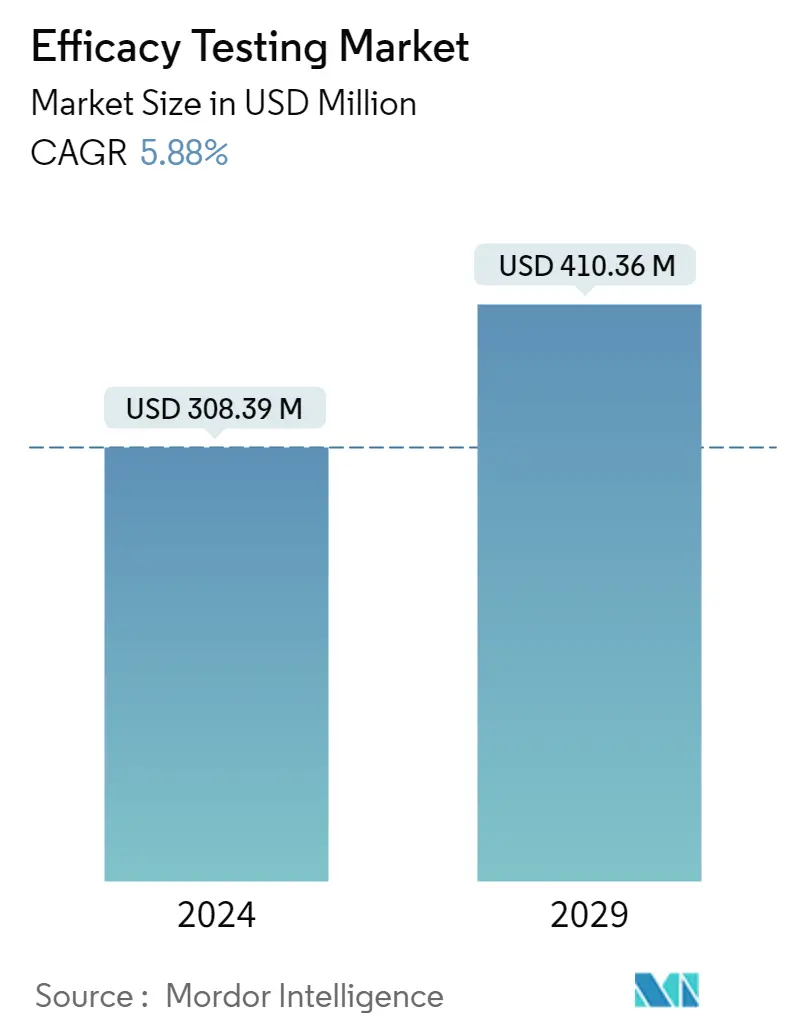
| Study Period | 2021 - 2029 |
| Market Size (2024) | USD 308.39 Million |
| Market Size (2029) | USD 410.36 Million |
| CAGR (2024 - 2029) | 5.88 % |
| Fastest Growing Market | Asia-Pacific |
| Largest Market | North America |
Major Players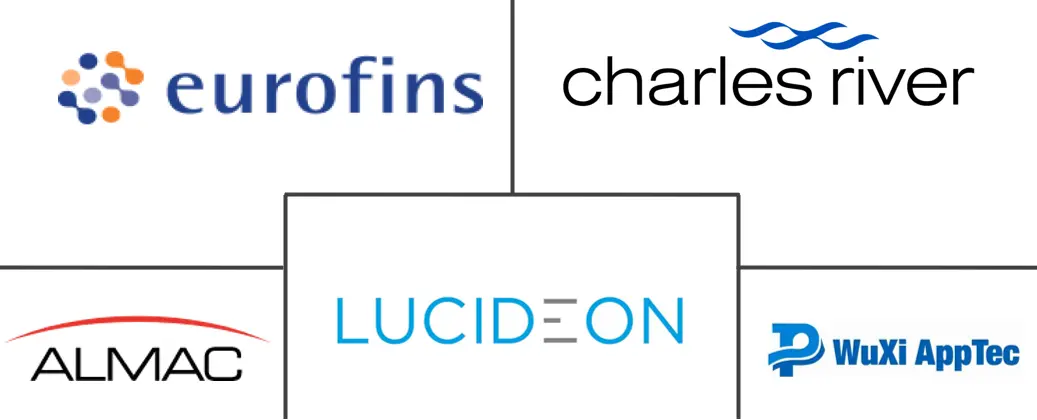
*Disclaimer: Major Players sorted in no particular order |
Efficacy Testing Market Analysis
The Efficacy Testing Market size is estimated at USD 308.39 million in 2024, and is expected to reach USD 410.36 million by 2029, growing at a CAGR of 5.88% during the forecast period (2024-2029).
The onset of the COVID-19 pandemic garnered efficacy testing for pharmaceutical products such as vaccines, drugs, and other medical products. A large customer base has fueled the sales of disinfecting products to prevent the spread of COVID-19 in their households. Thus, several laboratories and companies conducted efficacy testing of products. According to an October 2022 ARIC article, alcohol-based hand sanitizers (ABHS) were considered the gold standard for hand disinfection, but the required pH, viscosity, and hydrogen peroxide content of ABHS are a few parameters that are related to the products' functionality and acceptability by the users. Therefore, paying attention to and exercising control over the product's efficacy and safety is necessary. This increased the efficacy of testing during the pandemic. Additionally, in current times, the production of pharmaceutical products has increased, with an increase in research and development (R&D) of COVID-19 vaccines and drugs. This creates demand for efficacy testing of pharmaceutical products, ultimately fueling the market growth.
The studied market growth can largely be attributed to the factors such as an increase in outsourcing of research and development by the pharmaceutical sector and increasing adoption of the quality by design (QbD) approach.
Outsourcing assists organizations in the pharmaceutical sector to reduce both their operational and manufacturing costs and thereby minimize financial risk. Thus, pharmaceutical companies are increasingly outsourcing R&D activities to private contract research organizations (CROs) as a strategy for conducting research and development activities. For instance, in September 2022, Emyria Limited, a clinical-stage biotechnology company collaborated with PsychoGenics, a neuroscience preclinical drug discovery and contract research organization (CRO). Under this collaboration, Emyria uses PsychoGenic's drug discovery platform, SmartCube, which is a next-generation automated testing platform. Such instances are expected to increase the demand for efficacy testing products, and hence, it is anticipated to contribute to market growth over the forecast period.
Additionally, the QbD approach is adopted because it improves the functionality of efficacy testing by allowing for a systematic approach to drug development intended to enhance the quality by using analytical and risk management. Thus, the implementation of the QbD approach during efficacy testing enhances the development capability, speed, and formulation design. In addition, according to an article published in December 2021 in the AAPS open-access journal, the QbD strategy is known to have various benefits for the development of pharmaceutical products, including improved product and process expertise, reliable manufacturing processes, and regulatory flexibility regarding adjustments throughout the commercial phase with a significant focus on safety and efficacy testing. Thus, the demand for efficacy testing is increasing.
Moreover, according to the IFPMA's 2021 report, the annual R&D spending by the biopharmaceutical industry is 7.3 times higher than that of the aerospace and defense industries, 6.5 times more than the chemicals industry, and 1.5 times more than the software and computer services industry. The same source above also mentioned that the biopharmaceutical industry spent USD 196,000 million in 2021 and it is expected to increase to USD 213,000 million by 2024 over research and development activities. With increasing R&D in the biopharmaceutical industry for pharmaceutical product development, the adoption of the QbD approach is increasing among market players. This is expected to garner market growth. However, the high investment of time in testing procedures is likely to be an obstacle to growth.
Efficacy Testing Market Trends
This section covers the major market trends shaping the Efficacy Testing Market according to our research experts:
Cosmetics and Personal Care Products Segment is Expected to Witness Significant Growth Over the Forecast Period
The cosmetics and personal care products by application segment is anticipated to witness significant growth over the forecast period. The clinical testing of cosmetic products not only verifies the performance and safety of the cosmetic items but also gives its packaging and marketing greater authority and credibility. Moreover, with the increasing usage of cosmetics and personal care products, the demand for the efficacy testing of these products is increasing and further driving the segment growth.
Consumers' buying behavior for cosmetics and personal care products increased significantly during the pandemic and is anticipated to persist over the forecast period. Therefore, several companies are focusing on the efficacy testing of cosmetic products. For instance, in February 2021, Codex Beauty launched a consumer-facing efficacy testing label to help consumers understand its testing process and product claims. Codex Beauty Labs will display an easy-to-read efficacy testing panel on the labels of future products to explain the quantitative data behind product testing.
Moreover, efficacy testing is a series of methods used in cosmetics product research and development and is carried out to verify the claims made on packaging or in marketing and to test the product's intended use. Additionally, to make sure that the cosmetic items are safe for consumers to use directly on their skin, preservative efficacy tests are also carried out on cosmetic products. Thus, the regulation of the tests is mandatory, and this is creating numerous opportunities for cosmetics product efficacy testing. For instance, in May 2021, China's Standards for Cosmetic Efficacy Claim Evaluation came into effect. According to it, cosmetic products with efficacy claims shall be supported by an efficacy evaluation. As per the standards, a summary of efficacy evaluation results will be made available to the public through an online platform specified by the National Medical Products Association (NMPA). The efficacy of products will be subject to the mandatory test standard in the safety and technical standards for cosmetics.
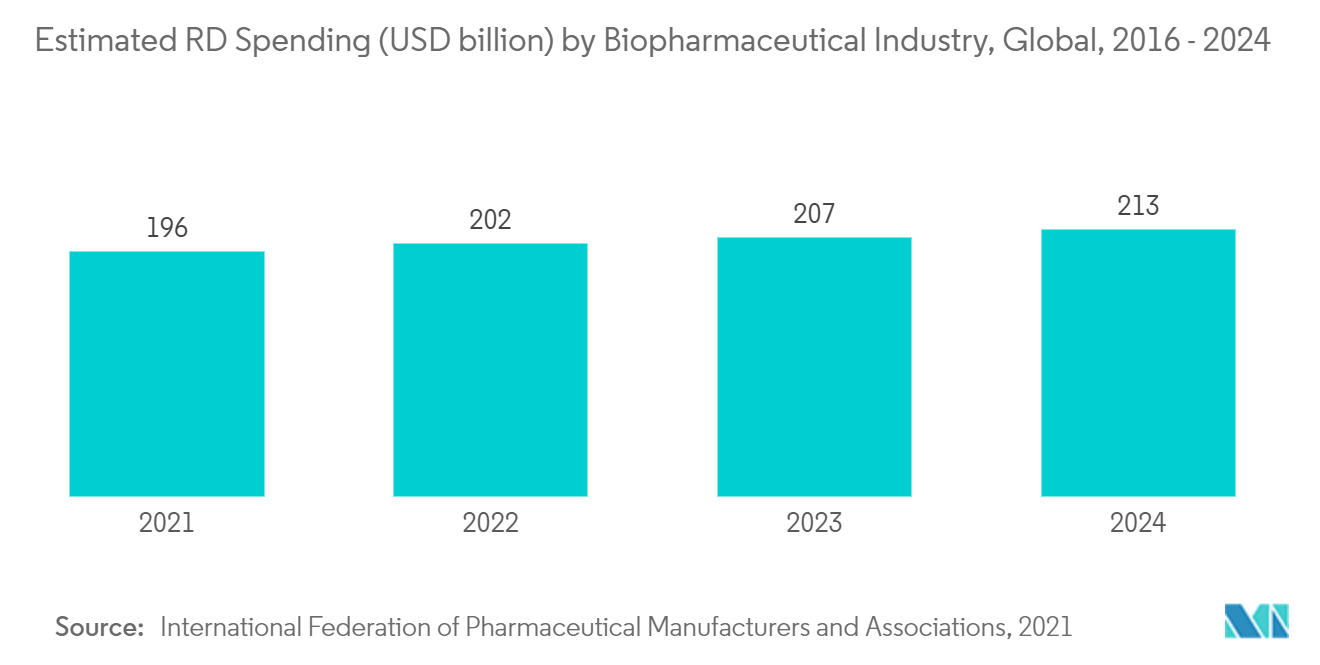
North America is Expected to Witness a Significant Growth Over the Forecast Period
North America is expected to dominate the overall efficacy testing market throughout the forecast period. Factors such as increasing R&D and adoption of the QbD approach among the market players in the region are predicted to drive market growth.
The pharmaceutical industry in North America is focusing more on outsourcing activities to CROs for drug development. In addition, governments across the region are also investing heavily in contract development and manufacturing organizations (CDMO), drug substance, and drug product manufacturing capacities. Recently HHS invested a hefty sum in Emergent BioSolutions to advance manufacturing capabilities and manufacturing capacity for a potential COVID-19 vaccine as well as therapeutics. In addition, Emergent BioSolutions signed an agreement with AstraZeneca to become the manufacturing partner for AstraZeneca's COVID-19 vaccine candidate. These CRO activities are anticipated to fuel market growth over the forecast period.
Furthermore, the presence of a well-established pharmaceutical industry in the region, the high R&D expenditure, the strong presence of major service providers, and the growing trend of outsourcing analytical testing by pharmaceutical and cosmetic companies in the region are several major factors that contribute to the overall market growth. For instance, according to the October 2022 update by OECD, pharmaceutical spending in the United States, Canada, and Mexico is 2.08, 1.72, and 1.34 (% of gross domestic product (GDP)), respectively. This shows the high involvement of major players, manufacturers, and government organizations in product development. This drives demand for efficacy testing services in countries across the region thereby driving the overall growth of the studied market.
Furthermore, according to the August 2021 update by FDA, access to the safest and cutting-edge pharmaceutical system benefits American consumers, thus pharmaceutical product development is increasing in the region. In addition, according to the source mentioned above, a drug must undergo testing before a pharmaceutical company may sell it in the United States. To demonstrate that the drug is safe and effective for its intended purpose, the manufacturer subsequently provides CDER with the results of these testing. Although CDER doesn't directly test pharmaceuticals, it undertakes some research on criteria for drug quality, safety, and effectiveness. The presence of such regulatory bodies to inspect pharmaceutical products is anticipated to fuel the studied market growth in the country.
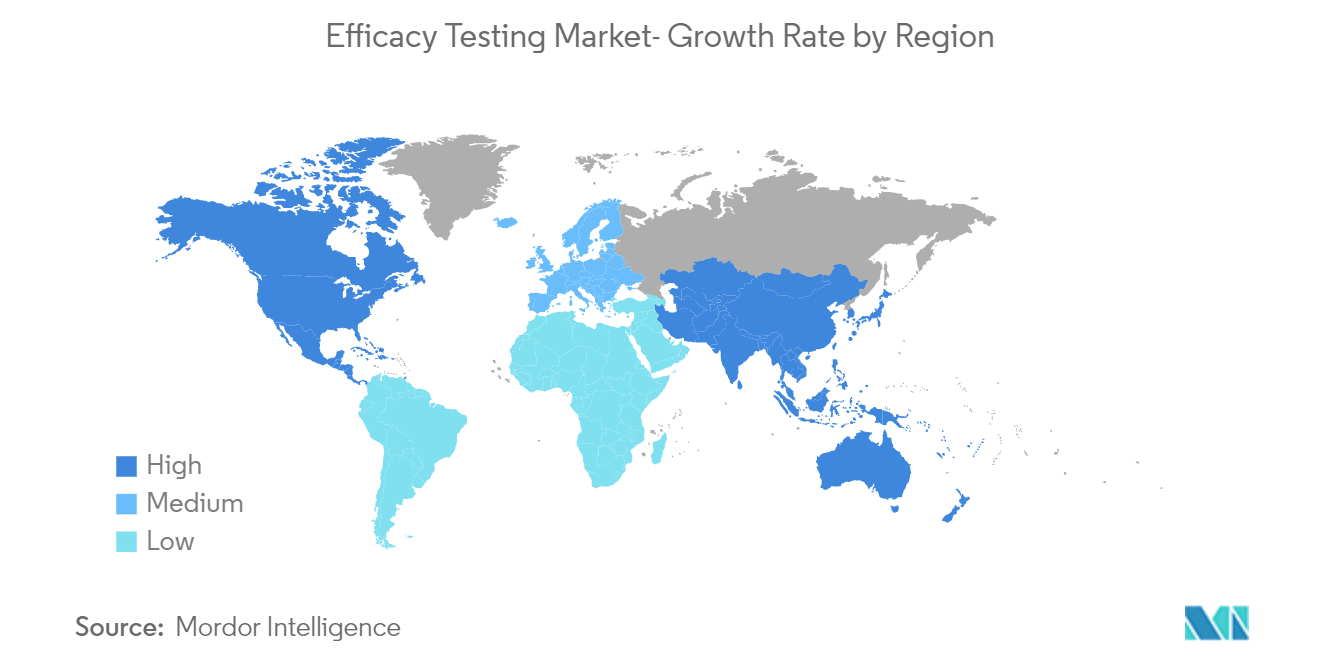
Efficacy Testing Industry Overview
The efficacy testing market is moderately competitive. Major market players are competing against each other by expanding their product portfolios through in-house development or technological acquisitions. A few companies currently dominate the market. These companies include Eurofins Scientific, Charles River Laboratories, Lucideon Limited, WuXi Apptec, and Almac Group. The key players have been involved in various strategic alliances such as acquisitions, collaborations, and the launch of advanced services to secure their position in the global market.
Efficacy Testing Market Leaders
-
Eurofins Scientific
-
Charles River Laboratories
-
Lucideon Limited
-
WuXi AppTec
-
Almac Group
*Disclaimer: Major Players sorted in no particular order
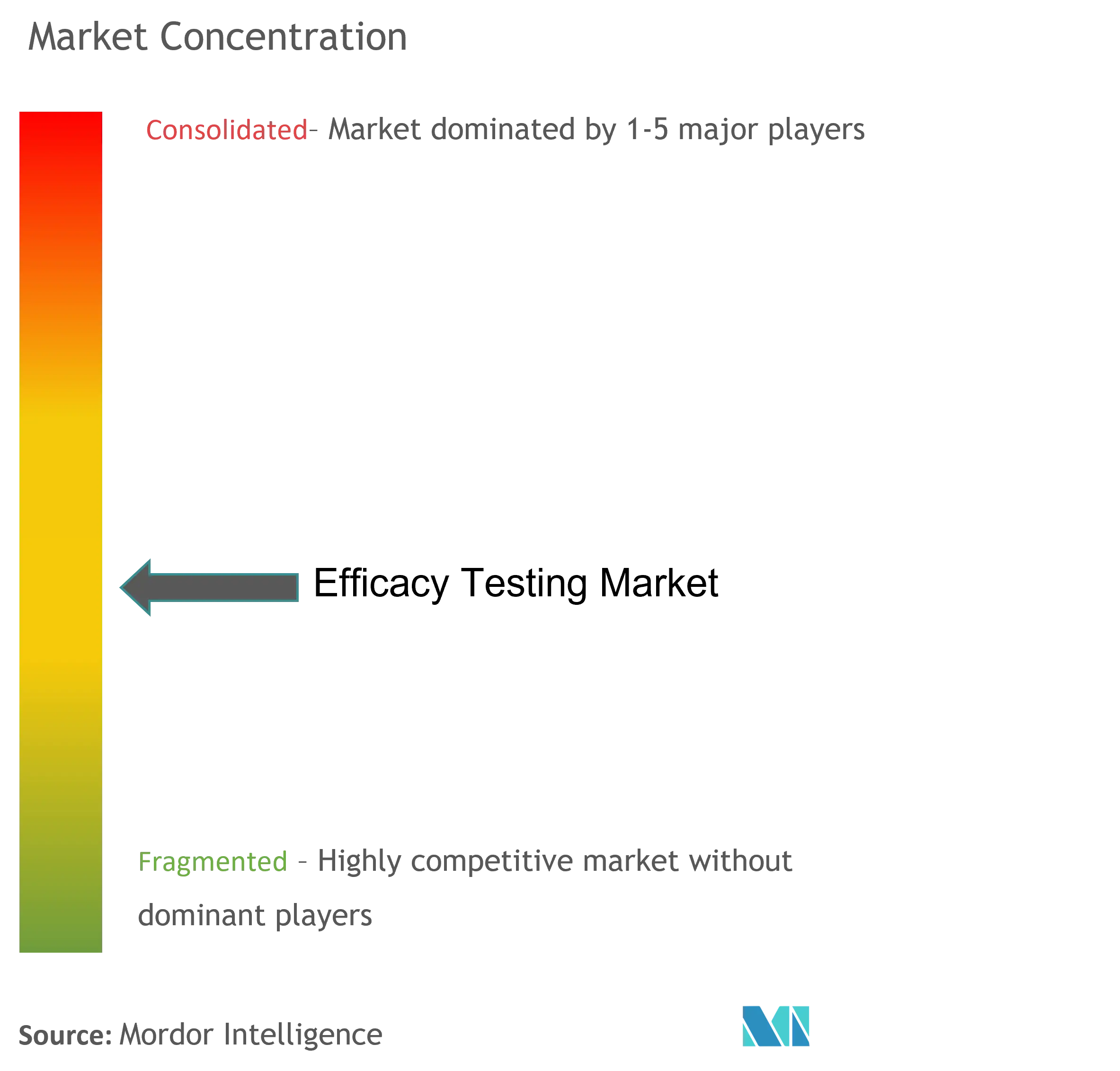
Efficacy Testing Market News
- In June 2022, Eurofins Cosmetics & Personal Care acquired a majority stake in CRA Korea Inc., a South Korea-based clinical testing laboratory primarily focused on providing safety and efficacy studies, consumer tests, and sensory evaluation to the cosmetics and personal care industry.
- In May 2022, the Pfizer-BioNTech COVID-19 vaccine demonstrated a strong immune response, high efficacy, and favorable safety in children 6 months to under 5 years following the third dose. Vaccine efficacy of 80.3% was observed in the descriptive analysis of three doses when Omicron was the predominant variant.
Efficacy Testing Market Report - Table of Contents
1. INTRODUCTION
- 1.1 Study Assumptions and Market Definition
- 1.2 Scope of the Study
2. RESEARCH METHODOLOGY
3. EXECUTIVE SUMMARY
4. MARKET DYNAMICS
- 4.1 Market Overview
-
4.2 Market Drivers
- 4.2.1 R&D Outsourcing by Pharmaceutical Companies
- 4.2.2 Increasing Adoption of QbD Approach
-
4.3 Market Restraints
- 4.3.1 High Investment of Time and Capital in the Testing Procedures
-
4.4 Porter's Five Forces Analysis
- 4.4.1 Bargaining Power of Suppliers
- 4.4.2 Bargaining Power of Buyers/Consumers
- 4.4.3 Threat of New Entrants
- 4.4.4 Threat of Substitute Products
- 4.4.5 Intensity of Competitive Rivalry
5. MARKET SEGMENTATION (Market Size by Value - USD million)
-
5.1 By Service Type
- 5.1.1 Antimicrobial Efficacy Testing
- 5.1.2 Disinfectant Efficacy Testing
-
5.2 By Application
- 5.2.1 Pharmaceutical Products
- 5.2.2 Cosmetics and Personal Care Products
- 5.2.3 Other Applications (Consumer Products &Medical Devices)
-
5.3 Geography
- 5.3.1 North America
- 5.3.1.1 United States
- 5.3.1.2 Canada
- 5.3.1.3 Mexico
- 5.3.2 Europe
- 5.3.2.1 Germany
- 5.3.2.2 United Kingdom
- 5.3.2.3 France
- 5.3.2.4 Italy
- 5.3.2.5 Spain
- 5.3.2.6 Rest of Europe
- 5.3.3 Asia-Pacific
- 5.3.3.1 China
- 5.3.3.2 Japan
- 5.3.3.3 India
- 5.3.3.4 Australia
- 5.3.3.5 South Korea
- 5.3.3.6 Rest of Asia-Pacific
- 5.3.4 Middle East and Africa
- 5.3.4.1 GCC
- 5.3.4.2 South Africa
- 5.3.4.3 Rest of Middle East and Africa
- 5.3.5 South America
- 5.3.5.1 Brazil
- 5.3.5.2 Argentina
- 5.3.5.3 Rest of South America
6. COMPETITIVE LANDSCAPE
-
6.1 Company Profiles
- 6.1.1 Eurofins Scientific
- 6.1.2 Charles River Laboratories
- 6.1.3 Lucideon Limited
- 6.1.4 WuXi AppTec
- 6.1.5 Almac Group
- 6.1.6 BluTest Laboratories, Ltd
- 6.1.7 BIOSCIENCE LABORATORIES, LLC
- 6.1.8 Abbott Analytical
- 6.1.9 Pacific BioLabs
- 6.1.10 Accugen Laboratories, Inc
- 6.1.11 Intertek Group plc
- 6.1.12 QIAGEN
- *List Not Exhaustive
7. MARKET OPPORTUNITIES AND FUTURE TRENDS
** Subject To AvailablityEfficacy Testing Industry Segmentation
Efficacy testing is a set of procedures in product research and development conducted to test the product's intended purpose and to support the claims displayed in the packaging. Efficacy studies allow us to objectively check or confirm the performance of a given product with specific products and scientific techniques. The Efficacy Testing Market is segmented by Service Type (Antimicrobial Efficacy Testing and Disinfectant Efficacy Testing) and Application (Pharmaceutical Products, Cosmetics and Personal Care Products, and Others) and Geography (North America, Europe, Asia-Pacific, Middle East and Africa, and South America). The market report also covers the estimated market sizes and trends for 17 different countries across major regions, globally. The report offers the value (in USD million) for the above segments.
| By Service Type | Antimicrobial Efficacy Testing | |
| Disinfectant Efficacy Testing | ||
| By Application | Pharmaceutical Products | |
| Cosmetics and Personal Care Products | ||
| Other Applications (Consumer Products &Medical Devices) | ||
| Geography | North America | United States |
| Canada | ||
| Mexico | ||
| Geography | Europe | Germany |
| United Kingdom | ||
| France | ||
| Italy | ||
| Spain | ||
| Rest of Europe | ||
| Geography | Asia-Pacific | China |
| Japan | ||
| India | ||
| Australia | ||
| South Korea | ||
| Rest of Asia-Pacific | ||
| Geography | Middle East and Africa | GCC |
| South Africa | ||
| Rest of Middle East and Africa | ||
| Geography | South America | Brazil |
| Argentina | ||
| Rest of South America |
Efficacy Testing Market Research FAQs
How big is the Efficacy Testing Market?
The Efficacy Testing Market size is expected to reach USD 308.39 million in 2024 and grow at a CAGR of 5.88% to reach USD 410.36 million by 2029.
What is the current Efficacy Testing Market size?
In 2024, the Efficacy Testing Market size is expected to reach USD 308.39 million.
Who are the key players in Efficacy Testing Market?
Eurofins Scientific, Charles River Laboratories, Lucideon Limited, WuXi AppTec and Almac Group are the major companies operating in the Efficacy Testing Market.
Which is the fastest growing region in Efficacy Testing Market?
Asia-Pacific is estimated to grow at the highest CAGR over the forecast period (2024-2029).
Which region has the biggest share in Efficacy Testing Market?
In 2024, the North America accounts for the largest market share in Efficacy Testing Market.
What years does this Efficacy Testing Market cover, and what was the market size in 2023?
In 2023, the Efficacy Testing Market size was estimated at USD 291.26 million. The report covers the Efficacy Testing Market historical market size for years: 2021, 2022 and 2023. The report also forecasts the Efficacy Testing Market size for years: 2024, 2025, 2026, 2027, 2028 and 2029.
Efficacy Testing Industry Report
Statistics for the 2024 Efficacy Testing market share, size and revenue growth rate, created by Mordor Intelligence™ Industry Reports. Efficacy Testing analysis includes a market forecast outlook 2029 and historical overview. Get a sample of this industry analysis as a free report PDF download.



